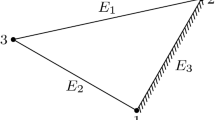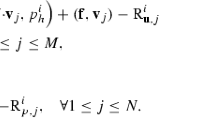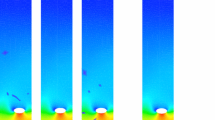Abstract
In this paper, a unified framework for a posteriori error estimation for the Stokes problem is developed. It is based on \([H^1_0(\Omega )]^d\)-conforming velocity reconstruction and \(\underline{\boldsymbol{H}}(\mathrm{div},\Omega )\)-conforming, locally conservative flux (stress) reconstruction. It gives guaranteed, fully computable global upper bounds as well as local lower bounds on the energy error. In order to apply this framework to a given numerical method, two simple conditions need to be checked. We show how to do this for various conforming and conforming stabilized finite element methods, the discontinuous Galerkin method, the Crouzeix–Raviart nonconforming finite element method, the mixed finite element method, and a general class of finite volume methods. The tools developed and used include a new simple equilibration on dual meshes and the solution of local Poisson-type Neumann problems by the mixed finite element method. Numerical experiments illustrate the theoretical developments.














Similar content being viewed by others
References
Achdou, Y., Bernardi, C., Coquel, F.: A priori and a posteriori analysis of finite volume discretizations of Darcy’s equations. Numer. Math. 96(1), 17–42 (2003)
Ainsworth, M.: A synthesis of a posteriori error estimation techniques for conforming, non-conforming and discontinuous Galerkin finite element methods. In: Recent advances in adaptive computation, vol. 383 of Contemp. Math., Amer. Math. Soc., Providence, pp. 1–14 (2005)
Ainsworth, M.: A posteriori error estimation for discontinuous Galerkin finite element approximation. SIAM J. Numer. Anal. 45(4), 1777–1798 (2007)
Ainsworth, M., Oden, J.T.: A posteriori error estimation in finite element analysis. Pure and Applied Mathematics (New York). Wiley, New York (2000)
Arbogast, T., Chen, Z.: On the implementation of mixed methods as nonconforming methods for second-order elliptic problems. Math. Comp. 64(211), 943–972 (1995)
Arnold, D.N., Brezzi, F.: Mixed and nonconforming finite element methods: implementation, postprocessing and error estimates. RAIRO Modél. Math. Anal. Numér. 19(1), 7–32 (1985)
Arnold, D.N., Brezzi, F., Fortin, M.: A stable finite element for the Stokes equations. Calcolo 21(4), 337–344 (1984)
Bank, R.E., Rose, D.J.: Some error estimates for the box method. SIAM J. Numer. Anal. 24(4), 777–787 (1987)
Bebendorf, M.: A note on the Poincaré inequality for convex domains. Z. Anal. Anwendungen 22(4), 751–756 (2003)
Becker, R., Capatina, D., Joie, J.: Connections between discontinuous Galerkin and nonconforming finite element methods for the Stokes equations. Numer. Methods Partial Differ. Equ. 28(3), 1013–1041 (2012)
Beirão da Veiga, L., Gyrya, V., Lipnikov, K., Manzini, G.: Mimetic finite difference method for the Stokes problem on polygonal meshes. J. Comp. Phys. 228(19), 7215–7232 (2009)
Bercovier, M., Pironneau, O.: Error estimates for finite element method solution of the Stokes problem in the primitive variables. Numer. Math. 33(2), 211–224 (1979)
Braess, D., Pillwein, V., Schöberl, J.: Equilibrated residual error estimates are \(p\)-robust. Comput. Methods Appl. Mech. Eng. 198(13–14), 1189–1197 (2009)
Braess, D., Schöberl, J.: Equilibrated residual error estimator for edge elements. Math. Comp. 77(262), 651–672 (2008)
Brezzi, F., Douglas, J., Jr.: Stabilized mixed methods for the Stokes problem. Numer. Math. 53(1–2), 225–235 (1988)
Brezzi, F., Falk, R.S.: Stability of higher-order Hood–Taylor methods. SIAM J. Numer. Anal. 28(3), 581–590 (1991)
Brezzi, F., Fortin, M.: Mixed and hybrid finite element methods, vol. 15 of Springer Series in Computational Mathematics. Springer, New York (1991)
Brezzi, F., Pitkäranta, J.: On the stabilization of finite element approximations of the Stokes equations. In: Efficient solutions of elliptic systems (Kiel, 1984), vol. 10 of Notes Numer. Fluid Mech. Vieweg, Braunschweig, pp. 11–19 (1984)
Burman, E., Ern, A.: Continuous interior penalty \(hp\)-finite element methods for advection and advection–diffusion equations. Math. Comp. 76(259), 1119–1140 (2007)
Carstensen, C.: A unifying theory of a posteriori finite element error control. Numer. Math. 100(4), 617–637 (2005)
Carstensen, C., Gudi, T., Jensen, M.: A unifying theory of a posteriori error control for discontinuous Galerkin FEM. Numer. Math. 112(3), 363–379 (2009)
Carstensen, C., Hu, J.: A unifying theory of a posteriori error control for nonconforming finite element methods. Numer. Math. 107(3), 473–502 (2007)
Cheddadi, I., Fučík, R., Prieto, M.I., Vohralík, M.: Guaranteed and robust a posteriori error estimates for singularly perturbed reaction–diffusion problems. M2AN Math. Model. Numer. Anal. 43(5), 867–888 (2009)
Crouzeix, M., Raviart, P.-A.: Conforming and nonconforming finite element methods for solving the stationary Stokes equations. I. Rev. Française Automat. Informat. Recherche Opérationnelle Sér. Rouge 7(R-3), 33–75 (1973)
Dari, E., Durán, R., Padra, C.: Error estimators for nonconforming finite element approximations of the Stokes problem. Math. Comp. 64(211), 1017–1033 (1995)
Destuynder, P., Métivet, B.: Explicit error bounds in a conforming finite element method. Math. Comp. 68(228), 1379–1396 (1999)
Dobrowolski, M.: On the LBB condition in the numerical analysis of the Stokes equations. Appl. Numer. Math. 54(3–4), 314–323 (2005)
Dörfler, W., Ainsworth, M.: Reliable a posteriori error control for nonconformal finite element approximation of Stokes flow. Math. Comp. 74(252), 1599–1619 (2005)
Droniou, J., Eymard, R.: Study of the mixed finite volume method for Stokes and Navier–Stokes equations. Numer. Methods Partial Differ. Equ. 25(1), 137–171 (2009)
Ern, A., Nicaise, S., Vohralík, M.: An accurate H(div) flux reconstruction for discontinuous Galerkin approximations of elliptic problems. C. R. Math. Acad. Sci. Paris 345(12), 709–712 (2007)
Ern, A., Stephansen, A.F., Vohralík, M.: Guaranteed and robust discontinuous Galerkin a posteriori error estimates for convection–diffusion–reaction problems. J. Comput. Appl. Math. 234(1), 114–130 (2010)
Ern, A., Vohralík, M.: Flux reconstruction and a posteriori error estimation for discontinuous Galerkin methods on general nonmatching grids. C. R. Math. Acad. Sci. Paris 347(7–8), 441–444 (2009)
Ern, A., Vohralík, M.: A posteriori error estimation based on potential and flux reconstruction for the heat equation. SIAM J. Numer. Anal. 48(1), 198–223 (2010)
Franca, L.P., Hughes, T.J.R., Stenberg, R.: Stabilized finite element methods. In: Incompressible computational fluid dynamics: trends and advances. Cambridge University Press, Cambridge, pp. 87–107 (1993, reprint 2008)
Franca, L.P., Stenberg, R.: Error analysis of Galerkin least squares methods for the elasticity equations. SIAM J. Numer. Anal. 28(6), 1680–1697 (1991)
Girault, V., Raviart, P.-A.: Finite element methods for Navier–Stokes equations, vol. 5 of Springer Series in Computational Mathematics. Theory and algorithms. Springer, Berlin (1986)
Glowinski, R., Pironneau, O.: On numerical methods for the Stokes problem. In: Energy methods in finite element analysis. Wiley, Chichester, pp. 243–264 (1979)
Hlaváček, I., Haslinger, J., Nečas, J., Lovíšek, J.: Solution of variational inequalities in mechanics, vol. 66 of Applied Mathematical Sciences. Springer, New York (1988) (translated from the Slovak by J. Jarník)
Houston, P., Schötzau, D., Wihler, T.P.: Energy norm a posteriori error estimation for mixed discontinuous Galerkin approximations of the Stokes problem. J. Sci. Comput. 22(23), 347–370 (2005)
Hughes, T.J.R., Franca, L.P., Balestra, M.: A new finite element formulation for computational fluid dynamics. V. Circumventing the Babuška–Brezzi condition: a stable Petrov–Galerkin formulation of the Stokes problem accommodating equal-order interpolations. Comput. Methods Appl. Mech. Eng. 59(1), 85–99 (1986)
Karakashian, O.A., Pascal, F.: A posteriori error estimates for a discontinuous Galerkin approximation of second-order elliptic problems. SIAM J. Numer. Anal. 41(6), 2374–2399 (2003)
Kim, K.Y.: A posteriori error analysis for locally conservative mixed methods. Math. Comp. 76(257), 43–66 (2007)
Ladevèze, P., Leguillon, D.: Error estimate procedure in the finite element method and applications. SIAM J. Numer. Anal. 20(3), 485–509 (1983)
Luce, R., Wohlmuth, B.I.: A local a posteriori error estimator based on equilibrated fluxes. SIAM J. Numer. Anal. 42(4), 1394–1414 (2004)
Maître, J.-F.: Personnal, communication. (2010)
Payne, L.E., Weinberger, H.F.: An optimal Poincaré inequality for convex domains. Arch. Rational Mech. Anal. 5, 286–292 (1960)
Pironneau, O.: Finite element methods for fluids. Wiley, Chichester (1989) (translated from the French)
Prager, W., Synge, J.L.: Approximations in elasticity based on the concept of function space. Quart. Appl. Math. 5, 241–269 (1947)
Repin, S.I.: A posteriori error estimation for nonlinear variational problems by duality theory. Zap. Nauchn. Sem. S.-Peterburg. Otdel. Mat. Inst. Steklov. (POMI) 243, Kraev. Zadachi Mat. Fiz. i Smezh. Vopr. Teor. Funktsii., vol. 28, pp. 201–214, 342 (1997)
Repin, S.I., Stenberg, R.: A posteriori error estimates for the generalized Stokes problem. Problems in mathematical analysis, No. 34, J. Math. Sci. (N. Y.) 142(1), 1828–1843 (2007)
Scott, L.R., Vogelius, M.: Conforming finite element methods for incompressible and nearly incompressible continua. In: Large-scale computations in fluid mechanics, Part 2. La Jolla, Calif., 1983. vol. 22 of Lectures in Appl. Math., Amer. Math. Soc., Providence, pp. 221–244 (1985)
Stenberg, R.: Some new families of finite elements for the Stokes equations. Numer. Math. 56(8), 827–838 (1990)
Taylor, C., Hood, P.: A numerical solution of the Navier–Stokes equations using the finite element technique. Int. J. Comput. Fluids 1(1), 73–100 (1973)
Verfürth, R.: A combined conjugate gradient–multigrid algorithm for the numerical solution of the Stokes problem. IMA J. Numer. Anal. 4(4), 441–455 (1984)
Verfürth, R.: A posteriori error estimators for the Stokes equations. Numer. Math. 55(3), 309–325 (1989)
Verfürth, R.: A posteriori error estimators for the Stokes equations. II. Nonconforming discretizations. Numer. Math. 60(2), 235–249 (1991)
Vohralík, M.: On the discrete Poincaré–Friedrichs inequalities for nonconforming approximations of the Sobolev space \(H^1\). Numer. Funct. Anal. Optim. 26(7–8), 925–952 (2005)
Vohralík, M.: A posteriori error estimates for lowest-order mixed finite element discretizations of convection–diffusion–reaction equations. SIAM J. Numer. Anal. 45(4), 1570–1599 (2007)
Vohralík, M.: A posteriori error estimation in the conforming finite element method based on its local conservativity and using local minimization. C. R. Math. Acad. Sci. Paris 346(11–12), 687–690 (2008)
Vohralík, M.: Residual flux-based a posteriori error estimates for finite volume and related locally conservative methods. Numer. Math. 111(1), 121–158 (2008)
Vohralík, M.: Unified primal formulation-based a priori and a posteriori error analysis of mixed finite element methods. Math. Comp. 79(272), 2001–2032 (2010)
Vohralík, M.: Guaranteed and fully robust a posteriori error estimates for conforming discretizations of diffusion problems with discontinuous coefficients. J. Sci. Comput. 46, 397–438 (2011)
Acknowledgments
We are indebted to Prof. Jean-François Maître (Ecole Centrale de Lyon) for showing us Lemma 3.1.
Author information
Authors and Affiliations
Corresponding author
Additional information
This work was supported by the GNR MoMaS project “Numerical Simulations and Mathematical Modeling of Underground Nuclear Waste Disposal”, PACEN/CNRS, ANDRA, BRGM, CEA, EdF, IRSN, France, the Finnish Research Programme on Nuclear Waste Management (KYT), and the Academy of Finland (decision number 133174).
Appendix
Appendix
1.1 Characterization of the inf–sup constants
In this section we will show a proof of Lemma 3.1, following the ideas of [45]. We start by the following well-known result, cf. [37, 54]:
Lemma 9.1
(Characterization of the \(\inf \)–\(\sup \) constant) The \(\inf \)–\(\sup \) constant \(\beta \) of (2.4) is the square root of the smallest eigenvalue to the following generalized eigenvalue problem
Proof
Define the following operators
so that it holds
for all \(\mathbf{{v}}\in \mathbf{{V}}\) and all \(q \in Q\). With this notation, we have
Substituting \(\mathbf{{z}}:=A^{1/2}\mathbf{{v}}\) gives
and hence the supremum is obtained by choosing
and we come to
Squaring gives
This is the Rayleigh quotient for the eigenvalue problem
Denoting \(\mathbf{{u}}=-A^{-1}B p\) this is written as
i.e., the operator form of (9.1a)–(9.1b). \(\square \)
We are now ready to prove Lemma 3.1.
Proof
(Proof of Lemma 3.1) In complete analogy to the preceding proof, with \(B, A\) replaced by
respectively, the \(\inf \)–\(\sup \) constant is the square root of the smallest eigenvalue \(\mu \) of
Written out explicitly, with \(\mathcal{V }^T=(\mathbf{{u}},p)^{T}\), this is
From here we see that \(\mu = \nu ^{2}\), where \(\nu \) is the eigenvalue to
Explicitly,
From here, we see that \(\nu =1\) is an eigenvalue. Suppose next that \(\nu \not =1\). Solving for \((\nu -1)\mathbf{{u}}\) in the first equation and substituting in the second one gives
Comparing with (9.2) shows that
giving
The constant in the stability condition is thus \(\min {|\nu |}\), i.e.
This completes the proof. \(\square \)
1.2 Equilibration for higher-order conforming and conforming stabilized finite element methods on dual meshes
This appendix concerns conforming and conforming stabilized finite element methods of Sect. 7.2. More precisely, for higher-order continuous pressure elements of Sect. 7.2.2, we show how to, from (7.29), obtain new normal flux functions \({\varvec{\varUpsilon }}_{F}(\mathbf{{u}}_h,p_h)\) for which (7.30) holds. This can be seen as an equivalent of the equilibration procedure of [4] on dual meshes.
Let \(D \in \mathcal D ^{\mathrm{int}}_h\), \(V\) be the associated vertex, \(T \in \mathfrak T _V\), and \(i = 1,\ldots ,d\). Denote the contribution to the correction terms of the right-hand side of (7.29) by
We will speak about these quantities as of “normal fluxes” \(m_{V,T,i}\). Remark that \(\left[\!\left[\nabla \mathbf{{u}}_h \mathbf{{n}}_F\right]\!\right] = 0\) on such sides \(F \in \partial \mathcal S _D^\mathrm{int}\) which are not contained in \(\partial \mathcal T _h\), cf. Fig. 1. Thus, from (7.29) and the above formula, we have
For the sake of simplicity, let us define \(m_{V,T,i}\) in the same way also for \(D \in \mathcal D ^{\mathrm{ext}}_h\) and the associated vertex \(V\).
Consider a fixed \(T \in \mathcal T _h\) and \(i = 1,\ldots ,d\). We have associated the normal flux \(m_{V_j,T,i}\) to each of the vertices \(V_{j}\) of \(T\), \(j = 1,\ldots ,d + 1\), cf. Fig. 15. We now want to equilibrate the normal fluxes \(m_{V_j,T,i}\): the purpose is to associate to each of the sides \(F_m \subset T\), \(m = 1,\ldots ,d + 1\), \(F_m \in \partial \mathcal S _h^\mathrm{int}\) such that \(F \subset \partial D\) for some \(D \in \mathcal D _h\), a correction normal flux \(\upsilon _{F_m,i}\) (in the direction of the fixed normal \(\mathbf{{n}}_F\)) such that the following holds (we give an example for \(d=2\), corresponding to Fig. 15):
The value \(m_{V_1,T,i}\) represents the total normal flux from the element \(T \cap D_1\) to the elements \(T \cap D_2\) and \(T \cap D_3\) (where \(D_i\) are the dual volumes associated with the vertices \(V_i\)). We clearly want to keep this total normal flux but to split it into the side normal fluxes \(\upsilon _{F_1,i}\) and \(\upsilon _{F_2,i}\); we proceed similarly for \(m_{V_2,T,i}\) and \(m_{V_3,T,i}\). The essential feature is that the corrections normal fluxes \(\upsilon _{F_m,i}\) are univocally defined for each side \(F_m\), \(m = 1,\ldots ,d + 1\), cf. once again Fig. 15.
It turns out that the system matrix in (9.5) is singular, as the sum of all the row vectors equals zero. It is, however, easy to check that its rank is equal to \(d\). Fortunately, the right-hand side in (9.5) is compatible: by the fact that the basis functions \({\varvec{\psi }}_{V_j,i}\) form a partition of unity on the chosen element \(T \in \mathcal T _h\),
we easily get
\(i = 1,\ldots ,d\). Thus, there exists a solution to (9.5). Note that (9.5) is always a system of a fixed small size \((d+1) \times (d+1)\) on each \(T \in \mathcal T _h\), for approximations (7.11a)–(7.11b) or (7.12a)–(7.12b) of any order \(k\).
Using \(\upsilon _{F_m,i}\) for each \(T \in \mathcal T _h\), we can now define new normal flux functions \({\varvec{\varUpsilon }}_{F}(\mathbf{{u}}_h,p_h)\) for sides \(F \in \partial \mathcal S _h^\mathrm{int}\) such that \(F \subset \partial D\) for some \(D \in \mathcal D _h\), in a way that (7.30) holds. More precisely, let
Note that, consequently, (9.5) gives
for every \(D \in \mathcal D ^{\mathrm{int}}_h\) and the associated vertex \(V\), \(i = 1,\ldots ,d\). Let \(F \in \partial \mathcal S _h^\mathrm{int}\) such that \(F \subset \partial D\) for some \(D \in \mathcal D _h\) and set
We then see that (9.4) together with (9.7) and (9.8) implies (7.30).
Rights and permissions
About this article
Cite this article
Hannukainen, A., Stenberg, R. & Vohralík, M. A unified framework for a posteriori error estimation for the Stokes problem. Numer. Math. 122, 725–769 (2012). https://doi.org/10.1007/s00211-012-0472-x
Received:
Revised:
Published:
Issue Date:
DOI: https://doi.org/10.1007/s00211-012-0472-x





